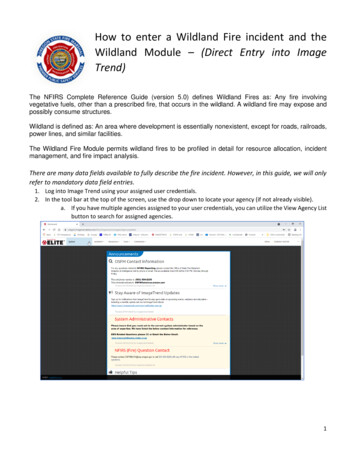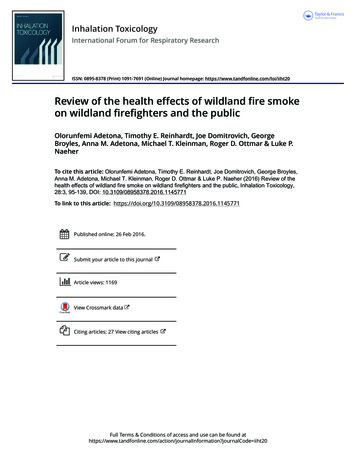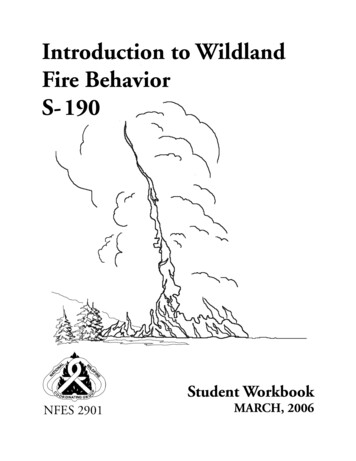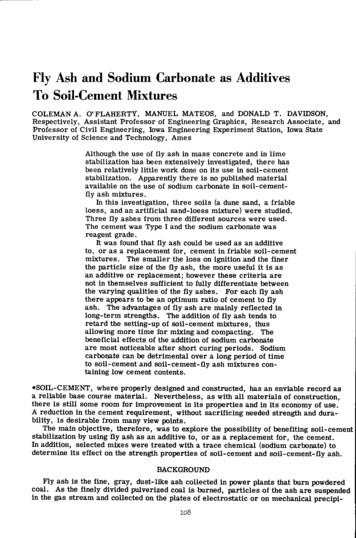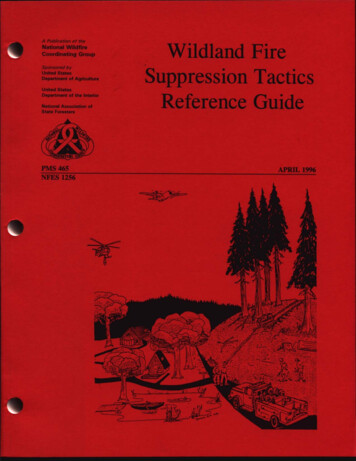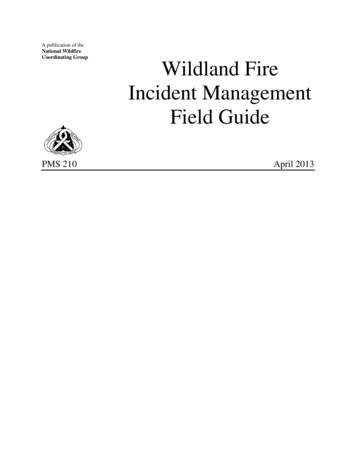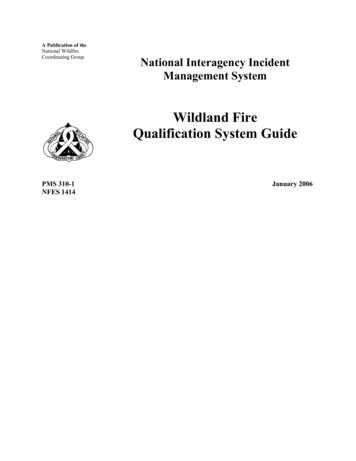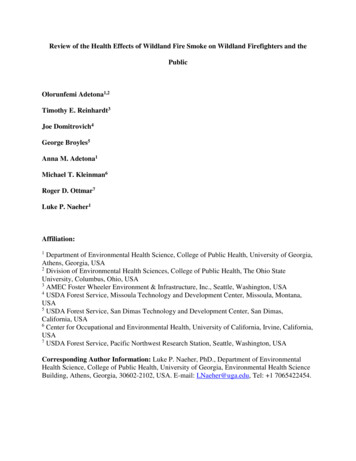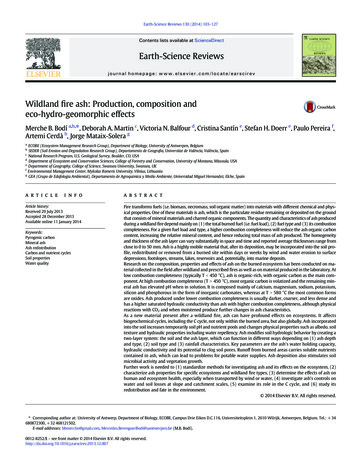
Transcription
Earth-Science Reviews 130 (2014) 103–127Contents lists available at ScienceDirectEarth-Science Reviewsjournal homepage: www.elsevier.com/locate/earscirevWildland fire ash: Production, composition andeco-hydro-geomorphic effectsMerche B. Bodí a,b,⁎, Deborah A. Martin c, Victoria N. Balfour d, Cristina Santín e, Stefan H. Doerr e, Paulo Pereira f,Artemi Cerdà b, Jorge Mataix-Solera gaECOBE (Ecosystem Management Research Group), Department of Biology, University of Antwerpen, BelgiumSEDER (Soil Erosion and Degradation Research Group), Departamento de Geografia, Universitat de València, València, SpainNational Research Program, U.S. Geological Survey, Boulder, CO, USAdDepartment of Ecosystem and Conservation Sciences, College of Forestry and Conservation, University of Montana, Missoula, USAeDepartment of Geography, College of Science, Swansea University, Swansea, UKfEnvironmental Management Center, Mykolas Romeris University, Vilnius, LithuaniagGEA (Grupo de Edafologia Ambiental), Departamento de Agroquimica y Medio Ambiente, Universidad Miguel Hernandez, Elche, Spainbca r t i c l ei n f oArticle history:Received 29 July 2013Accepted 28 December 2013Available online 11 January 2014Keywords:Pyrogenic carbonMineral ashAsh redistributionCarbon and nutrient cyclesSoil propertiesWater qualitya b s t r a c tFire transforms fuels (i.e. biomass, necromass, soil organic matter) into materials with different chemical and physical properties. One of these materials is ash, which is the particulate residue remaining or deposited on the groundthat consists of mineral materials and charred organic components. The quantity and characteristics of ash producedduring a wildland fire depend mainly on (1) the total burned fuel (i.e. fuel load), (2) fuel type and (3) its combustioncompleteness. For a given fuel load and type, a higher combustion completeness will reduce the ash organic carboncontent, increasing the relative mineral content, and hence reducing total mass of ash produced. The homogeneityand thickness of the ash layer can vary substantially in space and time and reported average thicknesses range fromclose to 0 to 50 mm. Ash is a highly mobile material that, after its deposition, may be incorporated into the soil profile, redistributed or removed from a burned site within days or weeks by wind and water erosion to surfacedepressions, footslopes, streams, lakes, reservoirs and, potentially, into marine deposits.Research on the composition, properties and effects of ash on the burned ecosystem has been conducted on material collected in the field after wildland and prescribed fires as well as on material produced in the laboratory. Atlow combustion completeness (typically T b 450 C), ash is organic-rich, with organic carbon as the main component. At high combustion completeness (T N 450 C), most organic carbon is volatized and the remaining mineral ash has elevated pH when in solution. It is composed mainly of calcium, magnesium, sodium, potassium,silicon and phosphorous in the form of inorganic carbonates, whereas at T N 580 C the most common formsare oxides. Ash produced under lower combustion completeness is usually darker, coarser, and less dense andhas a higher saturated hydraulic conductivity than ash with higher combustion completeness, although physicalreactions with CO2 and when moistened produce further changes in ash characteristics.As a new material present after a wildland fire, ash can have profound effects on ecosystems. It affectsbiogeochemical cycles, including the C cycle, not only within the burned area, but also globally. Ash incorporatedinto the soil increases temporarily soil pH and nutrient pools and changes physical properties such as albedo, soiltexture and hydraulic properties including water repellency. Ash modifies soil hydrologic behavior by creating atwo-layer system: the soil and the ash layer, which can function in different ways depending on (1) ash depthand type, (2) soil type and (3) rainfall characteristics. Key parameters are the ash's water holding capacity,hydraulic conductivity and its potential to clog soil pores. Runoff from burned areas carries soluble nutrientscontained in ash, which can lead to problems for potable water supplies. Ash deposition also stimulates soilmicrobial activity and vegetation growth.Further work is needed to (1) standardize methods for investigating ash and its effects on the ecosystem, (2)characterize ash properties for specific ecosystems and wildland fire types, (3) determine the effects of ash onhuman and ecosystem health, especially when transported by wind or water, (4) investigate ash's controls onwater and soil losses at slope and catchment scales, (5) examine its role in the C cycle, and (6) study itsredistribution and fate in the environment. 2014 Elsevier B.V. All rights reserved.⁎ Corresponding author at: University of Antwerp, Department of Biology, ECOBE, Campus Drie Eiken D.C.116, Universiteitsplein 1, 2610 Wilrijk, Antwerpen, Belgium. Tel.: 34680872300, 32 468121502.E-mail addresses: bbmerche@gmail.com, Mercedes.BerenguerBodi@uantwerpen.be (M.B. Bodí).0012-8252/ – see front matter 2014 Elsevier B.V. All rights 3.12.007
104M.B. Bodí et al. / Earth-Science Reviews 130 (2014) 103–127Contents1.2.3.4.5.Ash in the Earth system . . . . . . . . . . . . . .Ash definition . . . . . . . . . . . . . . . . . .Ash production, deposition and redistribution . . . .Ash sampling and analysis procedures . . . . . . .Ash chemical and mineralogical properties . . . . .5.1.Organic constituents . . . . . . . . . . . .5.2.Inorganic constituents . . . . . . . . . . .6.Physical properties of ash . . . . . . . . . . . . .7.Ash effects on ecosystem components . . . . . . .7.1.Nutrient cycles and soil chemical properties .7.2.Carbon cycle . . . . . . . . . . . . . . .7.3.Soil physical properties . . . . . . . . . . .7.4.Soil hydrology and erosion . . . . . . . . .7.5.Water quality . . . . . . . . . . . . . . .7.6.Microorganisms, plant germination and growth8.Concluding remarks and future research directions .Acknowledgments . . . . . . . . . . . . . . . . . . .References . . . . . . . . . . . . . . . . . . . . . . . . .1. Ash in the Earth systemVegetation fires have been an important natural process since theLate Silurian Period (420 Myr) when vascular plants first began tocover the land surface (Scott and Glasspool, 2006; Scott, 2010; Scottet al., 2014). Currently wildland fires affect 330–430 Mha of the globalland surface every year (Giglio et al., 2010), which equates to over 3%of the Earth's vegetated land surface. They affect a wide range of landcover types across the globe including boreal, temperate and tropicalforests, peatlands, shrublands and grasslands. Wildland fires are ignitednaturally by lightning and also by humans both accidentally and toaccomplish management objectives such as clearing, reduction of fuelloads or the reintroduction of fire into areas where fire has beensuppressed (Pyne et al., 1996). Fire can be seen as an important factorin soil formation, and heat and ash production are the main drivers ofthe changes that fire exerts on soils (Certini, 2013).Fire transforms fuels (i.e. biomass, necromass, soil organic matter)into materials with different chemical and physical properties. Following fire, a layer of ash from residues of this transformation covers thelandscape either in patches (Fig. 1a) or by blanketing the soil (Fig. 1b).This particulate residual material is the focus of this review. Ash canhave profound ecological, hydrological and geomorphological effects.For example, ash is of importance in several biogeochemical cycles,including the carbon (C) cycle (Santín et al., 2012), it modifies soilinfiltration and runoff generation, and it affects erosion rates (Woodsand Balfour, 2010; Bodí et al., 2012). Even after being removed fromthe soil surface by slope wash, wind erosion or dissolution, ash can beincorporated into the soil and can modify the physical and chemicalsoil properties that at the same time exert an influence on the soilmicroorganisms and vegetation germination and growth (Raison,1979).Research on the effects of fire on the landscape has paid relativelylittle attention to ash until recently. Ash is often rapidly (re)distributedand removed from burnt sites by wind and water erosion (MataixSolera, 1999; Cerdà and Doerr, 2008; Pereira et al., 2013a), whichfrequently occur before the commencement of post-fire field studies,so that the potential importance of ash can be overlooked. Studiesregarding wildfires and prescribed fires have focused mainly on theeffects of fire on vegetation recovery, soil properties such as waterrepellency, or runoff generation and erosion, all of which tend to bemore readily evident and accessible to quantify and characterize thanash. Another reason for the limited attention to date may be 21122122multi-disciplinarity required for the study of ash. Ash is usuallyconsidered separately from soil, vegetation, charcoal or from thebiogeochemical cycles of some nutrients. However, it is now recognizedthat ash is relevant to all of these aspects and should therefore beconsidered. Much of the scientific information available to date isgleaned from prescribed fires (e.g. Alexis et al., 2007, 2010; Arkle andPilliod, 2010; Stoof et al., 2012) because scientists have the opportunityto instrument the area before it is burned and collect samples before andafter the fire. Increasingly laboratory experiments (Raison et al., 1985a;Úbeda et al., 2009; Bodí et al., 2011a; Gabet and Bookter, 2011) are usedto collect data under controlled conditions.This review aims to provide a synthesis of the knowledge about ashfrom wildland fires (i.e. fires that affect managed and unmanagedareas), and the ash from prescribed or experimental fires and laboratoryexperiments where relevant. We first provide a definition of wildlandfire ash and describe how it is produced and deposited on the ground.Then ash constituents are described, paying special attention to theorganic fraction, which has seen little attention to date, followed bythe physical properties of ash. Subsequently, we outline ash effects ondifferent ecosystem components: nutrient cycles and soil chemicalproperties, the C cycle, soil hydrology and erosion, as well as waterquality. We also briefly cover ash effects on plant germination andgrowth; however, a comprehensive review of this broad topic is beyondthe scope of this present endeavor. Finally, we identify research gapsand highlight future directions regarding the study of ash producedduring wildland fires.2. Ash definitionIn this review we define wildland fire ash as the particulate residueremaining, or deposited on the ground, from the burning of wildland fuelsand consisting of mineral materials and charred organic components.Thus, we include the following components in our definition of wildlandfire ash:(1) An organic fraction derived from the combustion of theaboveground vegetation and/or the surface organic-rich layerof soils, often called necromass or plant litter and duff, on topof mineral soil, or organic soils like peat. Sometimes, organicmatter in the underlying mineral soil is also combusted and theinterface between the original organic layer and underlying soilbecome indistinguishable (see Section 4 on ash sampling).
M.B. Bodí et al. / Earth-Science Reviews 130 (2014) 103–127105Fig. 1. a) Ash covering the soil only beneath Pinus halepensis trees after a wildfire in Spain (inset, Scott Woods measuring the diameter of an ash patch); b) a thick ash layer blanketing thesoil surface following a conifer forest wildfire in Montana, U.S.A.Most of the organic components of ash are part of the “pyrogenic Ccontinuum” which includes the whole range of organic materialstransformed to some extent by charring, from slightly charredvegetation to charcoal or soot (Goldberg, 1985; Masiello, 2004).In some cases the organic fraction of ash can also contain unburntorganic materials, which have not been chemically modified bythe effect of fire, but have become part of the ash layer.(2) An inorganic fraction consisting of silicates, oxides, phosphates,carbonates, sulfates, and amorphous phases that either exist asprimary minerals in the plant materials or undergo a transformation as a result of the heating during fire (Ulery et al., 1993;Quintana et al., 2007; Vassilev et al., 2010). The silicate portioncan include phytoliths, which are siliceous structures found inmany species of plants (Albert and Cabanes, 2007; Morris et al.,2010). This fraction is often called “mineral ash” in the literatureon wildland fire or heating (Smith et al., 2010).(3) Mineral soil particles that originate from aeolian deposition toplant canopies and the soil organic layer or that are introducedinto the organic layer by bioturbation or freeze/thaw cyclesprior to fire (Frandsen, 1987). In addition, soil particles can be incorporated into the ash layer after post-fire rainstorm events(Woods and Balfour, 2010; Pérez-Cabello et al., 2012) or by bioturbation (Topoliantz et al., 2006).(4) Exogenous chemicals such as mercury (Caldwell et al., 2000;Biswas et al., 2008) and radionuclides (Paliouris et al., 1995;Gallaher et al., 2002) that were originally deposited from theatmosphere onto the vegetation canopy and soil organic layerand that survived volatilization during the fire. Though thesechemicals are not derived directly from the original organicmatter, and may only represent a very small fraction of ash,they can impart a distinct chemical signature to the ash (Smithet al., 2010).
106M.B. Bodí et al. / Earth-Science Reviews 130 (2014) 103–127Other definitions of ash have been provided by a range of disciplinessuch as sedimentology, ecology, coal studies or industries that producecombustion residues (Jones et al., 1997; Schmidt and Noack, 2000; Scottand Glasspool, 2007). It should be noted that in some cases theseresidues are not derived from vegetation, but from volcanic, waste orcoal mining and processing activities.1 Within the wildland fire researchcommunity a range of definitions is used. For instance Quill et al. (2010)defined ash as “a category of Thermally Altered Plant Matter (TAPM)that has been submitted to intense temperatures in the presence ofoxygen, and has whitish color and relatively greater inorganic mineralcontent than the original matter.” Brewer et al. (2013) use the terms“charred residues” and “post-fire residues” to include all of the resultantproducts from combustion. Others have also defined ash as a vegetationcombustion by-product, e.g. Raison (1979), Giovannini (1994), Forbeset al. (2006), Kinner and Moody (2010), Scott (2010) and Santín et al.(2012). The main difference between our definition and some of theother definitions of ash is the consideration of ash as consisting ofmore than residual mineral material left over from the combustion oforganic matter.3. Ash production, deposition and redistributionThe processes leading to ash generation by progressive heating andburning of fuel are complex (Pyne et al., 1996; Théry-Parisot et al.,2010). Complete combustion of organic fuels results in production andoxidation of volatiles or gases such as carbon dioxide (CO2), carbonmonoxide (CO), methane (CH4) or nitrogen dioxide (NO2), with onlymineral residue remaining (i.e. “mineral ash”; DeBano et al., 1998).However, under most wildland fire conditions, where oxygen availability can be locally limited, combustion is incomplete and some of the fuelis charred. This incomplete combustion generates pyrogenic organiccompounds. The term “pyrogenic organic matter” comprises all organiccompounds formed, or transformed during fire, and includes a continuum of C-rich solid organic materials, from partially charred vegetalbiomass through charcoal to soot (Goldberg, 1985; Schmidt andNoack, 2000). For instance, charcoal comprises larger particles thatretain enough physical and chemical properties to identify its biomasssource. On the other extreme of the pyrogenic continuum is soot,submicron particles that settle out in the atmosphere, formed bycondensation as a secondary product from the hot gases present inflames (Masiello, 2004).Wildland fires can burn under a combined set of conditions.During initial heating, thermal degradation (pyrolysis) releasesvolatile gases that promote combustion. In the presence of oxygenthere is a flaming phase, where temperatures can be between 450and 1400 C and fire can spread rapidly, yielding a mixture ofcharred particles and mineral ash (Ormeño et al., 2009; Saura-Maset al., 2009). Under conditions where oxygen is limited, smolderingcombustion takes place at temperatures of 250–450 C. The combustion process is more prolonged during this phase, typicallyconsuming “stumps, logs, downed branches, and “belowgroundbiomass” (duff, roots, and organic soils)” (Bertschi et al., 2003).In smoldering combustion, oxidation is more complete, more particulates and gas are released, and the end product is predominantlymineral ash (DeBano et al., 1998; Ormeño et al., 2009).The quantity of ash produced in a wildland fire depends mainly on(1) the total burned fuel (i.e. fuel load), (2) fuel type and (3) its1References related to ash from the wood industry or fly ash from coal combustion(Ram and Masto, 2013) are not considered in this review unless indicated. Despite somesimilarities between ash from the wood industry and from wildland fires, the starting materials, combustion conditions, and temperatures are not sufficiently comparable(Someshwar, 1996; Augusto et al., 2008). Properties of wood ash are only considered herewhen the material has been burned under laboratory conditions that are similar to thefield or laboratory conditions used in wildfire or prescribed fire research (e.g. Etiegniand Campbell, 1991; Someshwar, 1996; Demeyer et al., 2001).combustion completeness.2 For a given fuel load, a higher combustioncompleteness will reduce the ash C content, which will increase therelative mineral content, and reduce the total mass of ash produced(Úbeda et al., 2009). Within a fire, these parameters tend tovary spatially. In addition, biophysical conditions, such as soil microtopography, terrain topography, and exposure affect ash accumulationduring and after the fire. Winds during and after burning can, forexample, move ash from the production zone to other areas within oroutside the fire perimeter (Spencer et al., 2003; Pereira et al., 2013a).The thickness of the ash layer covering the ground can thus varysubstantially in space and time, from discontinuous small quantities ofash in wildland fires with low fuel loads and high combustion completeness (e.g. surface grassland fires) to thick layers of ash followingfires in, for example, forests with substantial forest floor fuel layers. Reported average ash thicknesses range from 0 to 50 mm (Table 1). Evenwithin a single fire, the blanket of ash can be very heterogeneous, notonly in depth but also in continuity. For example, a continuous ashcover (100%) has been reported by Cerdà and Doerr (2008), Woods andBalfour (2008) and Balfour and Woods (2013); Fig. 1b), whereas Laveeet al. (1995) reported a 30% cover and De Luis et al. (2003) found variableash covers, from 30 to 64% increasing with fire severity (Fig. 1a).The non-homogeneity of ash deposition and ash characteristics arenot only reflected in the spatial coverage of ash, but also in the rangeof the ash color. Patches may consist of white, gray and black ash,depending on the combustion completeness. When white ash (the resultof more complete combustion) forms, it is usually on top of a layer ofblack ash (Blank and Zamudio, 1998; Carvalho Jr. et al., 2001; Carvalhoet al., 2002).Ash may not remain on the soil surface for very long, since ash ishighly mobile and in some cases ephemeral, depending on its properties(such as solubility, weight, particle size or density), terrain characteristics and meteorological conditions after the fire. Much of the ash mightbe redistributed or removed from a burned site within days or weeksafter fire (Cerdà and Doerr, 2008; Pereira et al., 2013a). Ash can be incorporated into soils by downward migration (Pereira et al., 2013a).Woods and Balfour (2010) observed the presence of ash and charredmaterial within soil pores by examining soil thin sections of experimentally burned plots of Pinus ponderosa and Pseudotsuga menziesii vegetation after rainfall simulations. Ash incorporation into soil can beenhanced by bioturbation, for example, by the action of organisms likeearthworms (Topoliantz et al., 2006), and also by freeze–thaw cycles.We are not aware of any studies that have quantified ash movement inany detail, although Rumpel et al. (2009) made measurements fromburned plots in Senegal to determine how much pyrogenic C getsincorporated into the mineral soil and how much is moved off-site inrunoff. They found that 7–55% of pyrogenic C was subject to horizontaltransport, and another 23–46% subject to vertical transport.Some of the ash may be dispersed by wind, especially where highcombustion completeness has resulted in small light particles of mineralash. Mataix-Solera (1999) reported an almost complete removal of theash layer after only one day when wind speeds reached 90 km h 1following an experimental fire in eastern Spain where shrubs andherbaceous species were burned. Pereira et al. (2013a) measured theevolution of the thickness of the ash layer at the hillslope scale over a45-day period in a burned grassland area in Lithuania. Increases in ashthickness in some areas over time were attributed to ash redistributionby wind. After the first rains the ash was wetted, forming a crust on thesoil surface (see Sections 5.1 and 7.4) and making the ash more resistantto entrainment by wind.2We have chosen the term “combustion completeness” to describe the degree of oxidation within a given fuel. The terms “fire severity” or “burn severity” are avoided here in asfar as possible, because they do not necessarily relate closely to combustion completenessand describe the effect of a fire on ecosystem components, which includes, for example,not only the degree of fuel consumption, but also plant mortality or the changes to soilproperties (Keeley, 2009).
M.B. Bodí et al. / Earth-Science Reviews 130 (2014) 103–127Table 1Reported average depths of various ash deposits in forested wildland fire sites andestimated pre-fire fuel loads.LocationAverage depth(mm)Load(t ha 1)AuthorsNew Mexico (USA)California (USA)Eastern SpainMontana (USA)Colorado (USA)Colorado (USA)Victoria, 682–aCannon et al. (2001)Goforth et al. (2005)Cerdà and Doerr (2008)Woods and Balfour (2008)Larsen et al. (2009)Ebel et al. (2012)Santín et al. (2012)Pereira et al. (2013a)aBulk density not available.Some ash is moved by surface runoff to surface depressions orfootslopes (Novara et al., 2011; Santín et al., 2012; Pereira et al.,2013a; Fig. 2), to streams (Minshall et al., 1997; Ryan et al., 2011) andto lakes or reservoirs (Blake et al., 2006; Reneau et al., 2007), where ithas the potential to affect water quality and aquatic organisms. Floodplain or debris flow deposits often contain ash (Agnew et al., 1997;Lindell et al., 2010), which might persist over thousands of years indepositional features like alluvial fans (Meyer and Wells, 1997; Elliottand Parker, 2001; Bigio et al., 2010). Ultimately, ash or some of itsconstituents can be incorporated into marine deposits (Herring, 1985;Shin et al., 2002).4. Ash sampling and analysis proceduresAsh samples can be collected after wildland fires (e.g. Goforth et al.,2005; Bodí et al., 2011a; Balfour, in press), after prescribed or experimental burns (e.g. Ulery et al., 1993; Woods and Balfour, 2010; Pereiraet al., 2011) or produced in the laboratory (e.g. Gray and Dighton,2006; Úbeda et al., 2009; Quill et al., 2010; Stoof et al., 2010).Ash sampling following wildland fires or prescribed burns hasusually been done as soon as it is feasible using transects (Hoefenet al., 2009), grids (Ebel et al., 2012; Pereira et al., 2013a), spokes(Hoefen et al., 2009) or a random approach (Bodí et al., 2011a), depending on the field conditions. A small trench can be created to assess theash–soil profile to identify the ash layer and then the ash collectioncan be carried out using a sharp trowel, spoon (Brye et al., 2002;107Pereira et al., 2010; Balfour, in press) or a small vacuum device(Hughes et al., 2000). However, the ash–soil interface is sometimes difficult to identify and inclusion of mineral soil may occur during sampling, particularly where soils have a similar texture to ash or areorganic rich (see also Section 2).In the laboratory, ash has been produced in muffle furnaces (Úbedaet al., 2009; Bodí et al., 2011a; Hogue and Inglett, 2012; Balfour andWoods, 2013), or directly in aluminum pans (Soto and Diaz-Fierros,1993; Stoof et al., 2010; Hogue and Inglett, 2012). These approacheshave not followed a common methodology, using different heatingdurations e.g. 2 h (Gray and Dighton, 2006; Úbeda et al., 2009) or20 min (Arcenegui et al., 2008; Bodí et al., 2011a); different initialmoisture contents e.g. air-dried vegetation (Arcenegui et al., 2008) oroven-dried vegetation (24 h at 40 C, Gabet and Bookter, 2011); anddifferent fuel sizes e.g. ground vegetation (Gray and Dighton, 2006;Bodí et al., 2011a) or whole leaves (Úbeda et al., 2009; Quill et al.,2010). These different variables affect the ignition, combustion, andmaximum temperature reached during heating, and therefore thecharacteristics of the resulting ash are not directly comparable betweenstudies and may or may not be similar to ash from wildland fires. Therefore, caution is advised when comparing results from ash produced inthe laboratory with ash produced in the field (Raison, 1979; Gray andDighton, 2006; Bodí et al., 2011a; Hogue and Inglett, 2012). The studyof ash produced in the laboratory using muffle furnaces is neverthelessthought to be valuable since production conditions can be controlled,with Pereira et al. (2010) suggesting some methodological standardization. For instance the fuel (leaves and small branches) should be cleanedwith distilled water, dried at 24 h at room temperature and combustedfor 2 h. Another method that creates combustion residues more similarto wildland fire ash appears to be laboratory fire in individual aluminumpans (Hogue and Inglett, 2012).Once the ash is collected (or created), the methods used to analyzeash properties are largely the same as used for soil (Table 2), althoughsome methods are more appropriate than others considering the natureof ash (see Sections 6 and 7). In addition, the chemical instability ofsome ash precludes samples from being reused following hydrologicalanalysis, as the original characteristics may have been altered byhydration (Balfour and Woods, 2013).Several imaging techniques have been used to study ash productionand properties. High spatial resolution photography (HSRP) has provedto be very useful in monitoring ash evolution after a wildland fireFig. 2. Ash and sediments accumulated on a lower slope in the Sierra de Enguera (Spain) after a rain storm of 15 mm in 10 min, 2.5 months after a Pinus halepensis forest fire.
108Table 2Outline of the different methods used to analyze chemical and physical properties of ash.PropertyMethodReferencesColorChromameter (expressed in Munsell and in International Commission on Illumination notations)Munsell color chartASD Field Spec Pro Portable field spectroradiometerConventional gray scale chart with 20 scales(Tiffen Q-13)Precipitation with barium chlorideManometerBernard calcimeterTitration with NaOH to assess HCl that reacted with the carbonatesDry combustion in a TC analyzer (with prior heating 4 h at 450 C to eliminate TOC)Ratio 1:10 hydrochloric acid. Agitated on an orbital shaker at 300 rpmfor one week until a constant pH was reachedRatio 1:1 and 2:1 (ash: dH2O)Ratio 1:6 (ash: dH2O), agitated 6 h, filteredLeachate 25 g ash/100 mL distilled water; agitated 48 h; centrifuged; filtered; spectrometry analysisSolution 5 g ash/25 g of 0.1 M BaCl2; centrifuged 2 h; decanted; spectrometry analysisDigestion in HNO3–HCl solution; spectrometry analysisLeachate 1 g ash/40 mL distilled water; settled 24 h; filtered; spectrometry analysisElemental analyzerCombustion–reduction by gas chromatography with a thermic conductivity detectorSee Table 3X-ray diffractionGoforth et al. (2005)Úbeda et al. (2009), Bodí et al. (2011a, 2012), Pereira et al. (2010, 2012)Llovería et al. (2009), Roy et al. (2010)Roy et al. (2010)CaCO3pH and Electrical conductivityTotal N and CTotal organic carbon (TOC)MineralogyParticle sizeScanning electron microscopySieving and shaking 15 minGravimetryLaser difractometryDensityCore samples (in some cases repacked in the laboratory)Particle DensityPycnometerPorosityThin section analysisFrom bulk density and particle densityVacuum saturation methodRainfall simulationMinidisk InfiltrometerFalling head permeameterConstant head permeameterAir permeameterPressure plate: 0.01, 0.02, 0.03, 0.04 and 0.05, 0.2, 0.3, 1.0, 2.0 and 5.0 barHanging colu
Wildland fire ash: Production, composition and eco-hydro-geomorphic effects af, Artemi Cerdàb, Jorge Mataix-Solerag a ECOBE (Ecosystem Management Research Group), Department of Biology, University of Antwerpen, Belgium b SEDER (Soil Erosion and Degradation Research Group), Departamento de .


